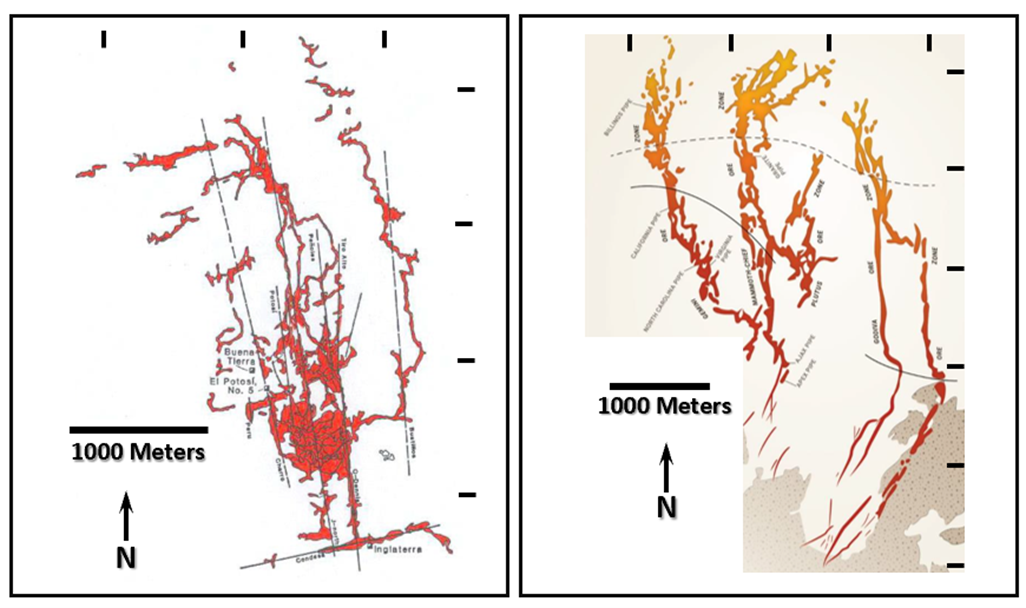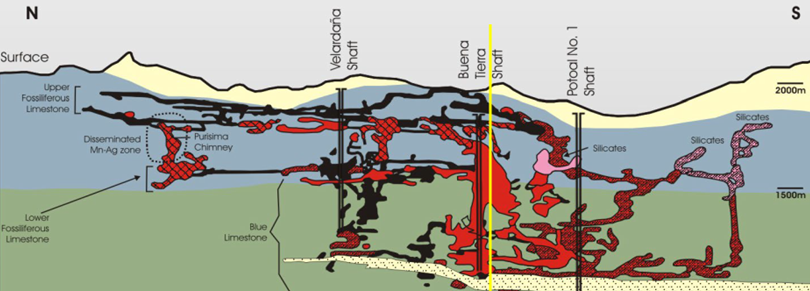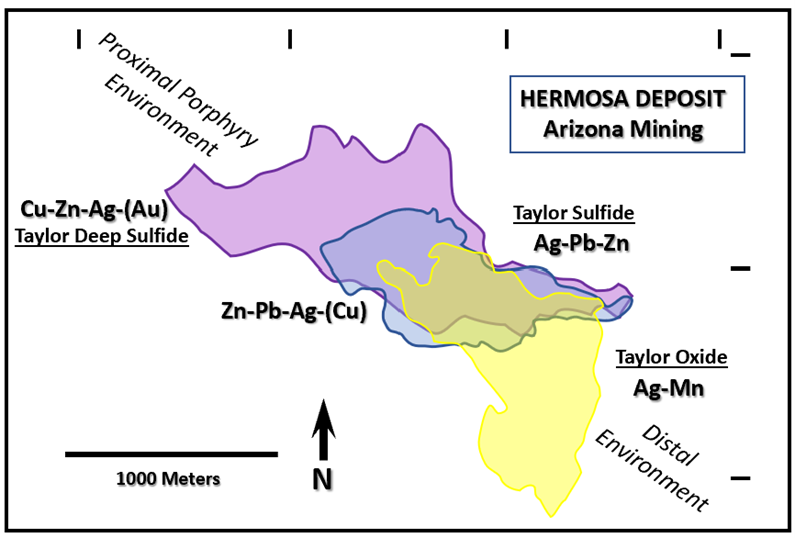102.7 Meters Grading 159 G/T (5.1 Oz/T) Silver, 5.4% Zinc and 5.3% Lead Including 18.5 Meters Grading 335 G/T (10.8 Oz/T) Silver, 2.2% Zinc and 12.0% Lead and 7.2 Meters Grading 349 G/T (11.2 Oz/T) Silver, 7.3% Zinc and 9.7% Lead
TUCSON, AZ / ACCESSWIRE / September 22, 2022 / Western Alaska Minerals (the "Company" or "WAM") (TSXV:WAM) is pleased to announce geological observations and assay results from massive sulfide mineralization cut at its Waterpump Creek Carbonate Replacement Deposit ("CRD") on its 100% owned Illinois Creek Project in western Alaska. The results incorporate visual data from drillholes WPC22-21 and 22 and assay data for WPC22-17 and 18 (See Table 1 and News Releases of July 5th and 20th, 2022). Visual data for Holes 21 and 22 are reported here for the first time. Assays for both, as well as WPC22-20, are pending.
The intercepts in all holes show multiple stages of sulfide mineralization characterized by alternating zinc-dominant sphalerite-rich and lead-silver dominant galena-rich sulfide mineralization zones. Sulfides thicken progressively towards drillholes WPC22-17 and 18 (48.8 and 101.7 meters respectively) both of which include significant zones of late-stage pyrite showing multiple stages of brecciation and mineralization.
The 102 meter intercept in drillhole WPC22-18 is by far the thickest and most mineralogically complex hole to-date with three intervals of high-grade Pb-Ag rich Ag-Pb-Zn mineralization. Additional intervals of Zn-dominant mineralization and lower-grade, late, multi-stage pyrite are also present. The combination of the abrupt thickening of mineralization towards drillhole WPC22-18 and its multi-stage complexity strongly indicate it is an important CRD feeder zone. Notably, WPC22-18 appears to lie at the intersection of the N-S Waterpump Creek graben and NE-SW Illinois Creek Fault, which suggests similar intersections identified elsewhere on the property may also host feeders that guided mineralizing fluids into the favorable carbonate host rocks.
"Following progressively thicker and more complex mineralization encountered in WPC22-17 and 18 and then seeing it thin again as we drilled further southward along the WPC graben strongly suggests we hit a feeder chimney located at the intersection with the Illinois Creek Fault," said Joe Piekenbrock, Chief Exploration Officer. "Combining this with the extensive historical mining five kilometers to the southwest along the Illinois Creek Fault strongly reinforces our interpretation that it is one of the major mineralization controls in the district and increases the importance of drilling along it, especially where it intersects other similar structures now seen in the CSAMT survey."
"It is remarkable to have cut a sulfide feeder zone so early in a CRD exploration program and this opens up a number of very exciting targets along the Illinois Creek Fault," said Dr. Peter Megaw, exploration advisor to WAM. "Having WPC22-18 to ground-truth geologic models and geophysical interpretations should greatly facilitate efficient exploration throughout this apparently very large scale CRD system".
Table 1. Assay results - WPC22-17 and 18
Drill hole | From (meters) | To (meters) | Thickness (meters) | Ag g/t | Ag Oz/t | Zn % | Pb % | AgEq g/t* |
WPC22-17 | 125.5 | 174.3 | 48.8 | 144 | 4.6 | 9.0 | 5.5 | 680 |
including | 125.5 | 135.3 | 9.8 | 428 | 13.8 | 15.9 | 14.1 | 1512 |
Including | 160.6 | 164.7 | 4.1 | 417 | 13.4 | 14.8 | 18.3 | 1587 |
WPC22-18 | 147.2 | 248.9 | 101.7 | 160 | 5.1 | 5.4 | 5.3 | 544 |
including | 158.6 | 165.8 | 7.2 | 349 | 11.2 | 7.3 | 9.7 | 947 |
including | 191.7 | 195.0 | 3.3 | 358 | 11.5 | 7.2 | 10.6 | 980 |
including | 223.8 | 242.3 | 18.5 | 335 | 10.8 | 2.2 | 13.5 | 798 |
* Silver Equivalent (AgEq) based on assumed prices of $22/oz Ag, $1.00/lb Pb, and $1.30/lb Zn
Waterpump Creek Drilling: Analysis To-Date
The manto mineralization encountered to date forms an elongate body 30 to 75 meters wide and 400 meters in length plunging gently to the south in the footwall dolomite adjacent to the WPC Creek structure. The overall architecture defined in the 2022 CSAMT profiles, indicates this structure is the western margin of a graben-like depression 500 to 600 meters wide that down-drops and drapes the overlying chlorite and graphite schist package onto the underlying dolomite section. As discussed earlier, there is an apparent chimney at the intersection of the WPC manto and the projection of the Illinois Creek Fault.
To better understand the trend and lateral continuity of the WPC manto, a profile of four drill holes spaced from 25 to 40 meters has been completed on Section 7104900, 50 meters south of the exceptionally thick interval encountered in WPC22-18. Figure 1 shows this EW cross-section (7104900N) which lies 250 meters south of the previously reported 7105150N section through mineralization in WPC22-07 (See News Release of August 2, 2022).
WPC22-20, 21 and 22 all cut significant massive sulfide intervals. From west to east the section shows: WPC22-21 cut 4.0 meters; WPC22-22 cut three intervals totaling 67.3 meters; and WPC22-20 cut two intervals totaling 32.1 meters of mineralization.
Mineralization in section 7104900 again shows mineralization replacing the dolomite along the fold hinge of the dolomite as it is draped and/or faulted into the Waterpump Creek graben. Alteration forms a halo around the massive mineralization often as bleached dolomite along with quartz, dolomite, and calcite veins. Fluorescent fugitive calcite veins are concentrated peripherally at or near the top side of the massive mineralization and form a local vector of up to 50-100 meters around the massive sulfide.

Figure 1. Cross-section (7104900N) (W-E)
Ongoing drilling has now moved 200 meters to the south to section 7104700 due to a wide expanse of wetlands that preclude drilling in 2022. Late spring drilling and specialized equipment will be needed to drill this gap in 2023.
Figure 2 is an updated longitudinal section along the axis of 2022 Waterpump Creek drilling. The mineralized body plunges to the south at 15-20 degrees along the western margin of the Waterpump Creek graben. Mineralization thickens dramatically south of 7105050N and shows the apparent chimney developing at the intersection of the WPC manto and the projection of Illinois Creek Fault. Future resource drilling should further define the geometries of the mineralized body.

Figure 2. Longitudinal Cross-section down the axis of the Waterpump Creek manto (N-S)
Figure 3 is a pierce point plan map of 2022 drilling at Waterpump Creek. The plan map shows the apparent intersection of the WPC manto and the projected trend of the Illinois Creek Fault. Importantly, Figures 3 shows the continuation of strong manto mineralization to the south of the likely WPC22-18 chimney at the intersection of the WPC Fault-controlled manto and the projection of the Illinois Creek syn-mineral fault.

Figure 3. Pierce point Plan Map of the Waterpump Creek manto
CRD Discussion
To better understand the implication of WAM's ongoing CRD exploration at Waterpump Creek and the greater Illinois Creek District, a brief discussion on CRD's geometries, zoning and scale is available on our website and as an Appendix to this news release.
CSAMT Geophysical Program
In addition to the ongoing two rig drill program, a major system-wide CSAMT (controlled-source audio-magnetotellurics) geophysical program was completed in June covering the +/- 8 km distance between the Illinois Creek oxide mineralization, the Last Hurrah area and the Waterpump Creek target area. Inversion modeling of the CSAMT sections is ongoing.
Preliminary results show a complex interplay of stacked thrusts and high-angle syn-mineral faults. The Waterpump Creek structure, the major mineralization control for the WPC manto, is apparent as the west bounding fault of the WPC graben which extends over at least 6 km of strike within the CSAMT sections south from Waterpump Creek through Last Hurrah to just east of the major East IC manto/gossan. Importantly, the survey shows the scale of the Illinois Creek CRD system is on par with some of the largest and richest CRD systems in the world, including the Santa Eulalia deposit in Mexico and the Tintic deposit in Utah (see the attached Appendix).
A preliminary geologic re-interpretation and specific target zones are shown in Figure 4 based on the CSAMT inversions. Three apparent NNE-trending extensional faults are evident in the inversions: The west and east bounding faults defining the Waterpump Creek graben; and Wade's Fault trend which shows major down-drop to the west preserving the entire 400-meter-thick prospective carbonate stratigraphy recognized in the District. The graben-like down-drop to the west of Wade's Fault suggests that the dolomite between the Waterpump Creek Fault and Wade's Fault is a horst block of prospective carbonate stratigraphy with only the lower dolomite section preserved.
The permissive stratigraphic section is characterized by an upper 100-meter thick, calcareous sandstone underlain by a 100-meter dolomitic sandstone and in turn, underlain by a 200-meter dolomite section. This permissive section lies immediately below the greenstone sill and a thin 20 to 50-meter thick graphitic schist. Late high-angle NE-trending faults, the Illinois Creek Fault and the Warm Springs Fault crosscut this framework.
Deep oxidation is apparent between the Illinois Creek and Warm Springs Faults as is demonstrated at the Illinois Creek oxide Au/Ag deposit and the East Illinois Creek manto. The Illinois Creek oxide Au/Ag deposit formed as replacement mineralization in the Illinois Creek Fault and the East Illinois Creek manto formed in the hanging-wall of the Illinois Creek Fault as a replacement body at the contact between calcareous and dolomitic quartzites roughly 100 meters below the greenstone sill.
Importantly, a major conductive anomaly is apparent in the data lying below: a shallow dipping Jurassic greenstone sill emplaced at the top of the prospective stratigraphy; and south of the Warm Springs Fault. This fault block was not tested in any of the historical drilling and suggests a major potential new target 4 x 2 kilometers in scale.
Two initial drill holes tests have been completed in August and September through the greenstone immediately west of Wade's Fault testing this highly prospective untested block south of the Warm Springs Fault. Drillhole IC22-01 has intersected 50+ meters of intense silicification, brecciation and massive pyrite mineralization with anomalous XRF base metal values below the greenstone sill. The hole was terminated due to poor drillhole conditions and a second hole IC22-02 roughly 500 meters to the northwest and closer to the Warm Springs Fault again intersected major silicification and brecciation with lesser but still significant pyrite component, again below the greenstone sill. The hole was lost due to intense sanding of the calcareous quartzite. A third hole testing west across Wade's Fault into this stratigraphy is ongoing. Importantly, this drilling roughly 3 kilometers south of the ongoing Waterpump creek drilling shows that mineralizing fluids of the Illinois Creek CRD system lie below the extensive greenstone sill and significantly expands the potential target area for replacement mineralization.

Figure 4. Preliminary Geologic interpretation and targeted zones based on the 2022 CSAMT program
Kit Marrs, Western Alaska Minerals CEO, stated "Our 2022 drilling program at Waterpump Creek has now outlined a 400 meter long trend of high grade silver-lead-zinc mineralization. This is a significant step towards defining an economic CRD deposit. Mineralization has thickened and become wider as the drilling has moved south along trend. Our 2022 drilling success, along with the results of the June CSAMT geophysical survey has demonstrated that we have a major CRD system with excellent potential for additional discovery. The two exploration holes, IC22-01 and IC22-02, completed to date on targets outlined by the CSAMT survey, demonstrate that we are just now understanding the potential of this CRD system."
Qualified Person
The qualified person who reviewed and approved the technical disclosure in this release is Stuart Morris, P. Geo., a qualified person as defined under National Instrument 43-101. Mr. Morris is an independent consultant with a MS in Economic Geology and 40 plus years of experience in mineral resources, mine, and exploration He is a Registered Geologist with the British Columbia Association of Professional Engineers and Geoscientists (BC-APEG) No. 135066 and with the Arizona State Board of Technical Registration No. 16289.
His review verified the data disclosed, including geology. sampling, analytical and QA/QC data underlying the technical information in this news release, including reviewing the reports of ALS, methodologies, results, and all procedures undertaken for quality assurance and quality control in a manner consistent with industry practice. All technical matters were consistent and accurate according to his professional judgement.
Quality Assurance/Quality Control
Quality Assurance/Quality Control of drill sample assay results are independently monitored through a quality assurance/quality control ("QA/QC") protocol which includes the insertion of blind standard reference materials, blanks, and duplicates at regular intervals.
All logging and sampling procedures are completed at WAM's core handling facilities located at the Illinois Creek mine camp in Alaska. Drill core is logged under an established procedure using Geospark commercial logging software, then diamond sawn on site. Half drill-core samples are then securely transported to ALS facilities in Fairbanks, Alaska from Illinois Creek under a strict chain of custody protocol. Sample pulps are then sent to ALS's lab in Vancouver, Canada, for analysis. Gold content is determined by fire assay of a 30-gram charge with ICP finish. Silver, lead, copper, and zinc along with other elements are analyzed by ICP methods utilizing a four-acid digestion. Over-limit samples for silver, lead, copper, and zinc are determined by ore-grade titration analyses. ALS Inc. is independent of Western Alaska Minerals and its affiliates.
ALS also performs its own internal QA/QC procedures to assure the accuracy and integrity of results. Parameters for ALS' internal and WAM' external blind quality control samples are acceptable for the elements analyzed. WAM is unaware of any drilling, sampling, recovery, or other factors that could materially affect the accuracy or reliability of the data referred to herein.
About WAM
WAM began trading on the TSX-V in November 2021 and maintains corporate offices in Alaska and Arizona. WAM fully controls all claims in the historic Illinois Creek Mining District located in western Alaska near the Yukon River, covering 73,120 acres (114.25 square miles or 29,591 hectares). The District was originally discovered by Anaconda Minerals Co. in the early 1980's. Since 2010, WAM and its private precursor company Western Alaska Copper & Gold Inc. has reassembled the Anaconda property package and been engaged in exploring the District. The District encompasses at least five deposits containing gold, silver, copper, lead, and zinc.
The Company currently has approximately 22,414,104 common shares issued and outstanding and 238,643 proportional shares issued and outstanding. Each proportional share is convertible to 100 common shares at the request of the shareholder and in the discretion of the Company. Because of these conversion rights, for market capitalization and financial analysis purposes, it is appropriate to convert the proportional shares to common shares and add the product of the conversion to the current number of common shares outstanding. When doing so, the sum of the approximate number of common shares (22,414,104) and converted proportional shares (23,864,300) equals 46,278,404 shares. Further information regarding the Company's share structure is available upon request.
On behalf of WAM
"Kit Marrs"
Kit Marrs
President & CEO
Phone: (520) 200-1667
For further information please contact:
Vanessa Bogaert, Director of Corporate Communications/IR at [email protected]
Or visit our website at: www.westernalaskaminerals.com
Forward Looking Information
Certain statements made, and information contained herein may constitute "forward looking information" and "forward looking statements" within the meaning of applicable Canadian and United States securities legislation. These statements and information are based on facts currently available to the Company and there is no assurance that actual results will meet management's expectations. Forward-looking statements and information may be identified by such terms as "anticipates", "believes", "targets", "estimates", "plans", "expects", "may", "will", "could" or "would". Forward-looking statements and information contained herein are based on certain factors and assumptions regarding, among other things, the estimation of mineral resources and reserves, the realization of resource and reserve estimates, metal prices, taxation, the estimation, timing and amount of future exploration and development, capital and operating costs, the availability of financing, the receipt of regulatory approvals, environmental risks, title disputes and other matters. While the Company considers its assumptions to be reasonable as of the date hereof, forward-looking statements and information are not guaranteeing of future performance and readers should not place undue importance on such statements as actual events and results may differ materially from those described herein. The Company does not undertake to update any forward-looking statements or information except as may be required by applicable securities laws.
Neither TSX Venture Exchange nor its Regulation Services Provider (as that term is defined in the policies of the TSX Venture Exchange) accepts responsibility for the adequacy or accuracy of this release.
Appendix 1 CRD Discussion
A critical element in effective exploration of carbonate replacement (CRD) deposits is a clear understanding of the orebodies' geometries and metal zonation patterns as seen in CRD analogs from around the world. Figure 1 show plan views of mineralized mantos and chimneys at the Santa Eulalia deposit in Mexico and the Tintic deposit in Utah. Mantos are often characterized as elongate rods of high-grade massive sulfide replacement mineralization in carbonate rocks often 20-100 meters wide, 10-40 metres thick and up to as much 3-4 kilometers in length. These ore body geometries typically result in a ‘skeletal' distribution of the orebodies exemplified in the figure below.

Figure 1. Skeletal Orebody Geometries Santa Eulalia District, Mexico and the Tintic District, Utah (courtesy Peter Megaw)
Figure 2 demonstrates that mineralized mantos can be stacked over a significant vertical relief in any given district. At Santa Eulalia, ore bodies are stacked over a kilometer of vertical stratigraphy. Importantly and as a rule of thumb in CRD exploration, the first favorable limestone or dolomite (i.e., the deepest) encountered by the ascending mineralizer is often by far the most productive. Mantos in general attenuate in scale as you move outward in the system.

Figure 2. Cross-section of the West Santa Eulalia District showing stacked mantos over 1km of stratigraphic thickness. (courtesy Peter Megaw)
The final critical targeting aspect in CRD exploration is the metal zonation patterns indicative of where in the ‘skeletal' geometry the encountered mineralization occurs. Figure 3 shows a plan map of the Hermosa/Taylor deposit in southern Arizona. The deposit exhibits classic CRD metal zonation both laterally and vertically between stacked mantos with proximal Cu-Zn-Ag-Au, intermediate Zn-Pb-Ag and distal Ag-Pb-Zn and Ag-Mn.

Figure 3. Plan view of the Hermosa/Taylor Deposit, AZ showing both lateral and vertical metal zonation in the stacked mantos. (modified from AZ Mining, 2018)
SOURCE: Western Alaska Minerals Corp




